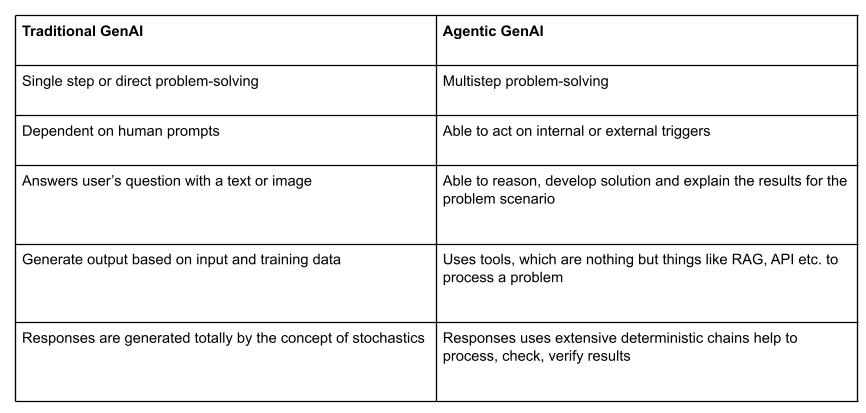According to a Gartner survey and industry trends, there is no doubt that we are in the era of AI evolution. AI agents are at the forefront of recent developments. Their ability to handle complex tasks enables full-scale automation. They break down tasks like the human mind and address these sub-tasks in a step-by-step, appropriate manner. Industry leaders such as Nvidia, Google, Meta, and Microsoft are betting on their immense potential. Even tech-averse companies are catching up with the trend of using agents to improve their bottom line.
The amazing potential lies in the fact that, unlike generative AI, agents don't just respond to user input; they can process a complex problem from start to finish. For example, in a scenario where an agent has to settle a customer's general insurance claim, the agent processes the required information, such as the claim form PDF, texts associated with the claim event, images of the damaged property, terms and conditions for claim settlement, and a database containing policy information (including whether the policy is active) and other important details. It reaches out to the relevant parties for any necessary data to process the claim. Currently, AI agents are capable of doing all of this autonomously, with minimum human oversight to ensure correct processing.
Traditional gen AI vs Agentic gen AI:

End-to-End Conceptual Working of an AI Claim Settlement Agent
This describes how an AI agent tasked with settling claims breaks down its work, handling the process from initiation to claim denial or reimbursement.
1. Claim Initiation and Processing Trigger: The workflow begins when a claimant sends a message (via email or the company's app) regarding a car accident and requests reimbursement. The agent analyzes the message and recognizes the customer's intent to initiate a claim process.
2. Data Extraction: This phase is crucial for converting unstructured information into structured, actionable data for systematic and secure processing. While classification assigns text to categories, extraction identifies and retrieves specific details. Instead of simply copying data, a language model generates structured outputs. For example, it can standardize phone numbers (e.g., converting "882 55645678" to "+91 88255645678") for consistency. This structured output (e.g., JSON) is generated by combining OCR and image models (if necessary, for scanning images) with Large Language Models (LLMs) to extract the required information.
3. External Service Integration: While generative AI can answer questions using pre-trained data, fine-tuning, or Retrieval Augmented Generation (RAG), AI agents require access to real-time corporate and external databases. Critically, agents must not only read data but also write it to ensure continuity. For instance, an agent can verify a contract number in a customer database and update a claim's status in a tracking system. It can even request missing information from customers or other sources, enabling autonomous operation.
4. Assessment, RAG, Reasoning, and Confidence: Administrative tasks often involve interpreting cases based on various rules, an area where AI excels. Since providing all context (e.g., policy terms) in a single query is impractical, a vector database is used to retrieve relevant snippets—a technique known as RAG. To enhance accuracy, the AI is prompted to "think aloud" before making an assessment, similar to solving a math problem step by step. This reasoning process is beneficial in several ways:
- It provides clear explanations to customers.
- It helps engineers understand the model's errors.
- Furthermore, it ensures the model's answer is logically derived, not random.
Confidence estimation is essential for accuracy. With effective few-shot learning, models can assess their own certainty. This allows businesses to set thresholds, routing uncertain cases to human review while automating high-confidence cases for efficiency.
With the development of increasingly efficient and open-source models, AI agents are poised to become even more powerful and impactful.
To work on similar and various other AI use cases connect with us at
https://www.lotuslabs.ai/
To work on computer vision use cases get to know our product Padme
https://www.padme.ai/